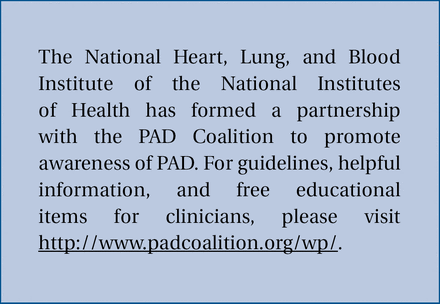Summary
Patients with peripheral artery disease often experience difficulty walking and painful cramps because of the narrowing of arteries in the legs. This painful condition, known as intermittent claudication (IC), can range in severity from being mildly irritating to extremely debilitating. The efficacy and safety of VLTS-934, a compound believed to increase microvascular blood flow, was evaluated in a Phase 2b randomized, double-blind, placebo-controlled multicenter trial of patients with IC conducted in the United States.
- cardiology clinical trials
- hypertensive disease
Patients with peripheral artery disease (PAD) often experience difficulty walking and painful cramps because of the narrowing of arteries in the legs. This painful condition, known as intermittent claudication (IC), can range in severity from being mildly irritating to extremely debilitating. The efficacy and safety of VLTS-934 (Valentis, Inc.), a compound believed to increase microvascular blood flow, was evaluated in a Phase 2b randomized, double-blind, placebo-controlled multicenter trial of patients with IC conducted in the United States. VLTS-934 is a non-ionic, block co-polymer known as a poloxamer. In vitro studies have shown that VLTS-934 binds to damaged cell membranes, which subsequently leads to a decrease in cytokine (IL8, IL6 and MCP1) release and inflammation. This cellular repair is hypothesized to result in better functioning of the surrounding microvasculature.
One hundred and fifty seven participants diagnosed with severe IC secondary to PAD and were randomized in a 1:1 ratio to receive either VLTS-934 (79) or a saline placebo (78). The treatments were administered as 21 intramuscular (IM) injections (2 mL each) into each leg. The injections were administered in a specified pattern under local anesthesia: three rings × 4 injections per ring above the knee in the superior aspect of the patella, two rings × 4 injections below the knee in the tibialis arterior muscle, and one injection in the superior aspect of the popliteal fossa. The primary outcome measure was the change in peak walking time (PWT) from the baseline evaluation to 90 days post-injection.
Results of the trial were disappointing. At day 90, both groups showed improvement, but there was no statistically significant difference between the two treatment groups in PWT as measured on an escalating treadmill. No treatment effect was observed in the secondary outcome measures of PWT at day 30, ankle-brachial index at day 30 and day 90, total work capacity at day 30 and day 90, or quality of life at day 90. According to statements made by the manufacturer, there are no plans to further pursue development of the drug. “While disappointing, the uniformity of the data between the groups suggests that these results are a very accurate picture of the placebo effect in subjects with peripheral arterial disease and may be considered in the design of future claudication trials”, said principal investigator P. Michael Grossman, MD.

The National Heart, Lung, and Blood Institute of the National Institutes of Health has formed a partnership with the PAD Coalition to promote awareness of PAD. For guidelines, helpful information, and free educational items for clinicians, please visit http://www.padcoalition.org/wp/.
- © 2006 MD Conference Express










